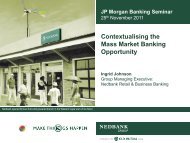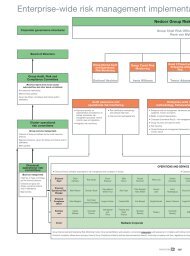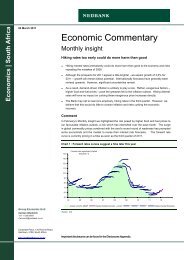NEDBANK CAPITAl - Nedbank Group Limited
NEDBANK CAPITAl - Nedbank Group Limited
NEDBANK CAPITAl - Nedbank Group Limited
- No tags were found...
You also want an ePaper? Increase the reach of your titles
YUMPU automatically turns print PDFs into web optimized ePapers that Google loves.
isk and BALANCE SHEET management reportDefaulted loans and advances increased by 56,3% to R27 045 million, while specific impairments increased to R7 830 million for thesame period. This resulted in a decrease in the coverage ratio from 32,0% in 2008 to 29,0% in 2009 as shown below.Defaulted loans and advances, specific impairments and coverage ratio30 00034,025 00032,027 04532,020 00030,0Rm17 30129,0Defaulted loans and advances15 00028,0PercentageSpecific impairments10 00026,0Coverage ratio (%)7 8305 0005 54224,02008 200922,0The coverage ratio is the amount of specific impairments thathave been raised for the total defaulted loans and advances.This is effectively the inverse of the expected recoveries ratio.The expected recoveries are equal to the defaulted loans andadvances less the specific impairments, as specific impairmentsare raised for any shortfall that would arise after all recoveriesare taken into account.The expected recoveries of defaulted loans and advancesinclude recoveries as a result of liquidation of security orcollateral, as well as recoveries as a result of a client curing orpartial client repayments.The absolute value of expected recoveries of defaultedaccounts (which includes security values) will increase as thenumber of defaults increase. The expected recovery amountwill in most instances be less than the total defaulted exposure,as it is seldom the case that 100% of the defaulted loan wouldbe written off.A decrease in the coverage ratio (or increase in the expectedrecoveries ratio) may arise as a result of the following:• Expected recoveries improving due to higher recoveries beingrealised in the loss given default (LGD) calculation.• A change in the defaulted product mix, with a greaterpercentage of products that have a higher security value(and therefore a lower specific impairment), such as securedproducts (home loans and commercial real estate).• An increase in the collateral value, which is an input into theLGD calculation and would result in a decrease in the LGD(and decrease in specific impairments).• A change in the mix of new versus older defaults as, in mostproducts, the recoveries expected from defaulted clientsdecrease over time.• A change in the writeoff policy, such as extending the periodprior to writing off a deal that will result in a longer period inwhich recoveries can be realised.The decrease in the group’s coverage ratio is due largely tothe change in the defaulted-product mix arising from the highamount of residential mortgage defaults in <strong>Nedbank</strong> Retail,as well as a higher amount of commercial mortgage anddevelopment loan defaults in <strong>Nedbank</strong> Property Finance.The total defaulted loans and advances increased by R9,7billion from 2008 to 2009. Residential mortgages accountfor 61% of this increase. Defaulted residential mortgagescontributed 57,6% to the total defaulted loans and advancesin 2008 and this increased to 59,0% in 2009. Residentialmortgages have lower coverage ratios than most other assetclasses due to the high amount of security generally held andtherefore higher expected recoveries.Similarly, defaulted commercial mortgages and developmentloans increased by R2,6 billion from 2008 to 2009 andcontributed 5,1% of the total defaulted loans and advancesin 2008, increasing to 13,0% in 2009. The majority of theexposures that defaulted were fully secured and thereforespecific impairments increased by only R216 million from 2008to 2009.148<strong>NEDBANK</strong> GROUP ANNUAL REPORT 2009

















